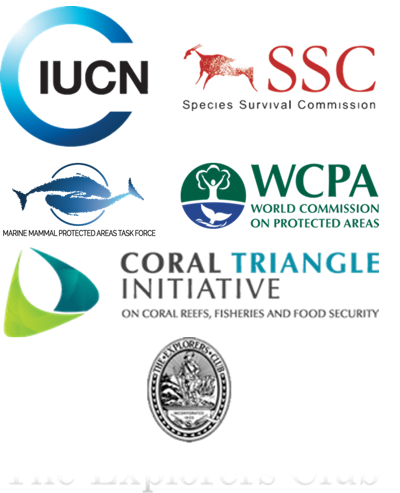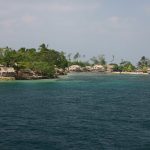Avid diver Rachel Mason recounts her incredible experience on the Underwater360 Expedition, where she came eye to eye with a school of hammerheads, face to face with dolphins and left in awe by the largest mammal to ever live, the blue whale. In this first part of a three-part series, Rachel introduces us to the ever-surprising world of the Banda Sea:
You always worry don’t you, when your baggage has been allegedly “checked through” multiple flight legs to reach your liveaboard start point, with the prospect of thereafter being at sea for 10 days. BCD and Regulator could end up MIA, and then what do you do when you have already committed to the diving version of BYOB (bring your own BCD)?! For DaDa Li, ADEX’s Freediving Ambassador this was a very real situation. We were extremely grateful to Gian Paulo Franchini, the owner of the Samambaia, who very generously extended an invitation for us to stay on the boat the night before we were supposed to embark on this epic journey, giving all errant belongings the chance to catch us up, and an additional opportunity to sample what we would come to know as the truly outstanding cuisine from the galley.
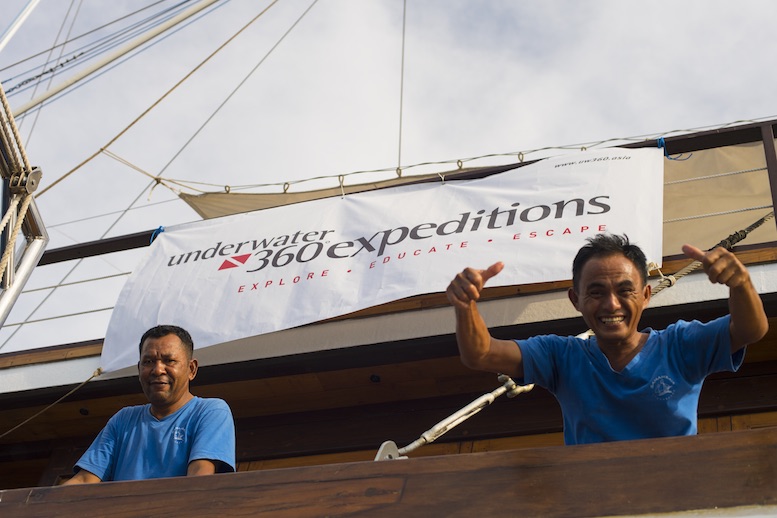
The crew on board. “We are welcomed with open arms and a steady hand as we clamber down the stairs and drop onto the dive deck, which astonishes us with its size.” © Aaron Wong
We are bookending this UW360 Expedition, meeting with provincial government representatives, the fisheries department, tourism boards, the Navy, universities, dive operators and the Coral Triangle Centre (CTC), all of whom are committed to putting dive tourism in the Banda Sea on the map, but we want to support them in doing this sustainably. Judy Lowe, ADEX Amabassador and PhD Student presents the culmination of what has been four years of research into dive tourism and its impact on the conservation of coral reefs and livelihoods of local fishers. She talks about how this could be achieved working with the local communities, respecting traditional marine tenure, ultimately securing the future livelihoods for local fishermen and their families, as well as the environmental future of the area for future generations. We are also in the thrall of Benjamin Kahn of APEX Environmental, world-renowned cetacean expert, who regales us with tales of the “Banda Blues”; their destination is the Banda Sea but the reasons they come here is a mystery Ben has been trying to solve for many years, so the data we collect from any sightings will make a significant contribution to piecing the puzzle together.
And so the stage is set. We race across the water of Ambon Harbour in the tenders sent to collect the cast and crew. We collectively take a breath as we round on the Samambaia, a traditional 40-metre, two-mast phinisi schooner. We are welcomed with open arms and a steady hand as we clamber down the stairs and drop onto the dive deck, which astonishes us with its size, the orderly pristine stations and gleaming tanks, nestled in the curved edges of the beautifully finished wood that surrounds us throughout this vessel. (You can find out more about the traditions and folklore of building these majestic ships in this edition of Asian Diver.)
The journey begins
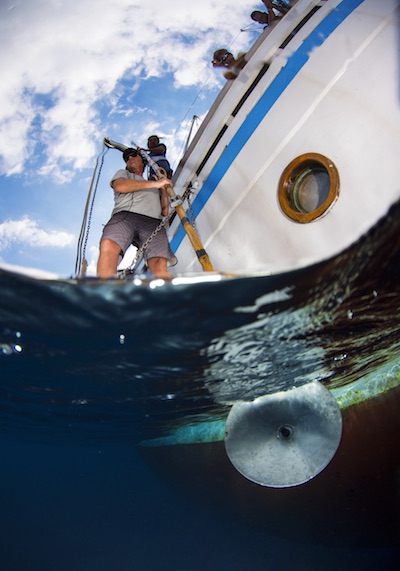
Benjamin Kahn listening out for whales. “This expedition is not just about the diving: We are here with world-renowned cetacean expert, Benjamin Kahn of APEX Environmental, to spot and observe various whale species.” © Aaron Wong
I am startled awake the following morning with the metallic rumbling sound of the anchor being raised and engines roaring to life as we set out towards Nusa Laut, our first stop on what will be a 900-nautical-mile journey.
No sooner have we embarked upon our first leg, we hear, “BLOW! 11 o’clock,” shouted across the observation deck, and the clanging sound of the whale bell to let everyone know there has been a sighting. The cast and crew flood the dive deck and jostle for position to observe three blue whales foraging, the 10-metre-high blasts of water from their blowholes, mist bright in contrast to the advancing stormy skies and the depths into which they arch, fluke and then dive for 11 minutes at a time, in search of more krill. To see blue whales so close and so early on in our journey was extraordinary; Ben tells us they are usually not observed until much further away from Ambon, so already this is some new and very interesting information to contribute to the study.

ADEX Ambassador of Photography Aaron Wong, underwater videographer Pepe Arcos, and underwater photographer Alan Lo, relaxing on the deck.
As we approach our first stop, the whale bell gives way to the dive bell, and we suit up for our check dive, Kampung Ahmed. The tenders zip over the water, and we can already see that the visibility is amazing. There is nothing like the feeling as we back-rolled into the blue, where the light spots of rain give way to a brand new world below, the intermittent hiss and sigh of my regulator, the squeak of my ears as we descend, and the wonder as I witness for the first time the prolific marine life in this part of the world. The fish are in abundance, busying about their lives; the coral is spectacular, and without pause. This would set the scene for nearly every dive of the expedition.
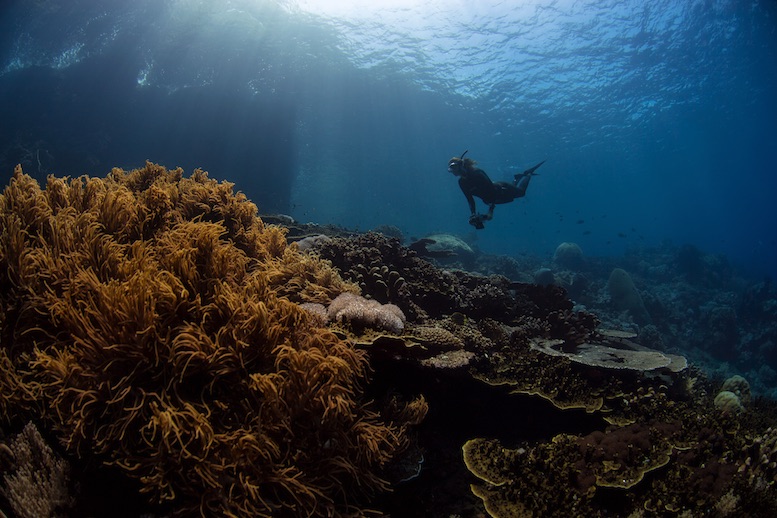
Senior Editor Alice Grainger freediving in the Banda Sea. © Aaron Wong
A sundowner at the back of the boat gazing into the middle distance, I thought I saw a dolphin. And then a sudden hive of activity; careering out of the water, splashes everywhere, these are spinner dolphins. Exclamations from the bow lead me forward, and there are four more, so close to the boat you can see their faces. What an astonishing first day. Started with whales, finished with dolphins.
A hint of the hammers…
We start the next day diving the Amphitheatre at Suangi, which is carpeted with cabbage coral as far as the eye can see. Silver trevallies, a romantic pair of fire dartfish, a turtle, bumphead parrotfish, a banded sea snake and a rare rockmover wrasse, and this was the first dive of the day! We intersperse three dives today with whale patrol. Heading further into the Banda Sea, we encounter a huge pod of spotted dolphins, so sociable they make a beeline for the boat. You can see how muscular their bodies are as they leap again and again and bow ride as the Samambaia carves her way though the water. The lesser-known species of “Unhappy Chef” was also sighted, as we brave the downpour and dash back to the dive deck for yet another pod of dolphins, just as lunch is being served; absolutely everything stops for the cetacean sightings!
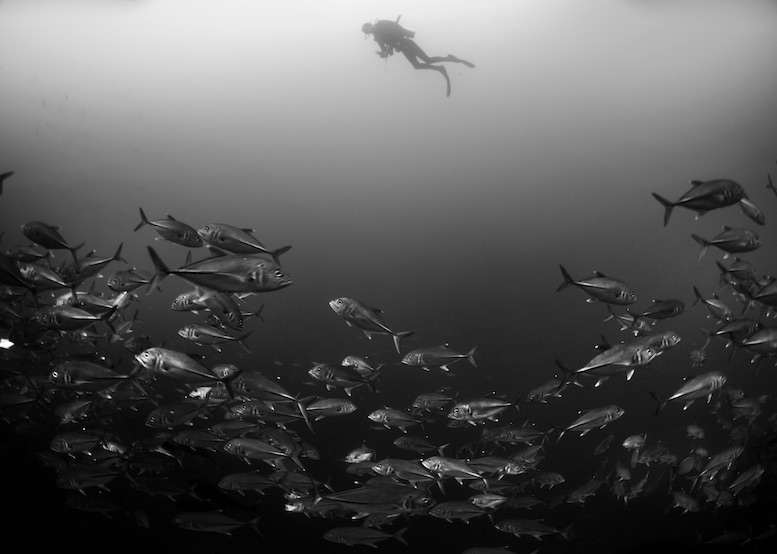
“Silver trevallies, a romantic pair of fire dartfish, a turtle, bumphead parrotfish, a banded sea snake and a rare rockmover wrasse, and this was the first dive of the day!” © Aaron Wong
Each dive I find myself becoming more and more amazed by the coral. It’s staggering to me that I am seeing this for the first time and impresses on me more than ever the importance of this expedition. Gently drifting along as we dive Pulau Run, there is a sharp drop in temperature, a shiver also of excitement, and with that, in the gloom at the bottom of the wall at about 35 metres, we see a scout. Around three metres long, a hammerhead shark is lurking. We hope that there will be more to follow, but as gracefully as he weaved into view, he weaves away, leaving us wanting more!
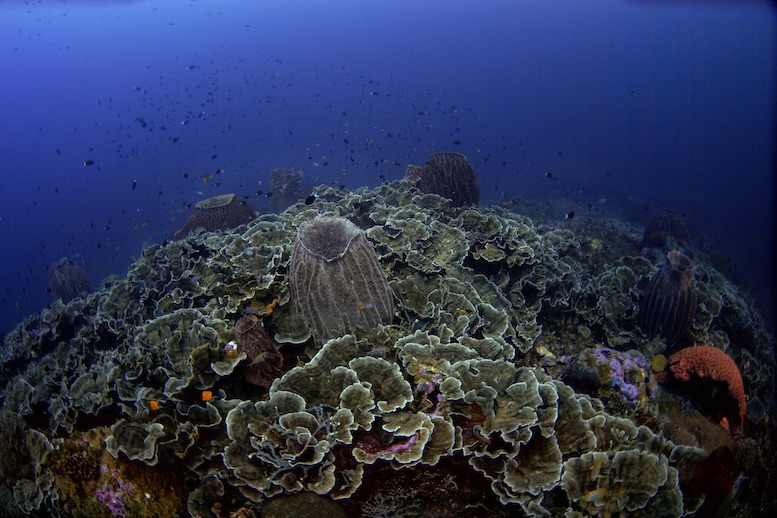
“Each dive I find myself becoming more and more amazed by the coral. It’s staggering to me that I am seeing this for the first time and impresses on me more than ever the importance of this expedition.” © Aaron Wong
The day is not yet done, and as we set sail again, we sit at the ship’s bow. Nikki “Spinner Dolphin” Friedli is in the bow netting just above the water for a bird’s-eye view of a chorus line of bottle-nosed dolphins and a calf weaving in and out of one another. Faster and faster they cling to the bow as if to race with us. It’s a mega-pod of 130 dolphins – they are everywhere. We are fortunate to briefly sight a pair of beaked whales too – they are extremely shy and sightings are rare.
Another day dawns with a clanging whale bell and the mad dash to the dive deck, toothbrush still in tow, to be greeted by about 100 melon-headed whales congregating. They stay with us for an hour, logging (resting) on the surface and “rooster tailing” – slapping their tails on the water signalling to one another.
Immediately as you descend at Pulau Hata, there is a beautiful swim-through, with 50 metres visibility and teeming with life – the globe of azure invites you in. The esteemed underwater photographer and ADEX Ambassador, Aaron Wong, takes a stunning photograph from below, and as the sun beams through the void, it seems very apt that it resembles the shape of a heart. A stunning wall with huge barrel sponges and gorgonian fans, the colours and diversity of the coral and the fish is mesmerising. A vertical school of barracuda shimmering in the sunlight, the silhouette of freediver Dada Li against them leaves a striking image in my mind.
!["There is a beautiful swim through [...] and as the sun beams though the void it seems very apt that it resembles the shape of a heart." © Aaron Wong](https://staging.uw360.asia/wp-content/uploads/2016/11/DSC_7431.jpg)
“There is a beautiful swim-through […] and as the sun beams through the void, it seems very apt that it resembles the shape of a heart.” © Aaron Wong
Five hammerhead sharks at Karang Hatta in the afternoon bodes well, whilst the water temperature is a bit chilly when they are imminent. The activity is definitely hotting up, but we are shocked and saddened to discover that the population of green and banded sea snakes at Gili Manuk is severely depleted and we only see a handful despite diving here all day.
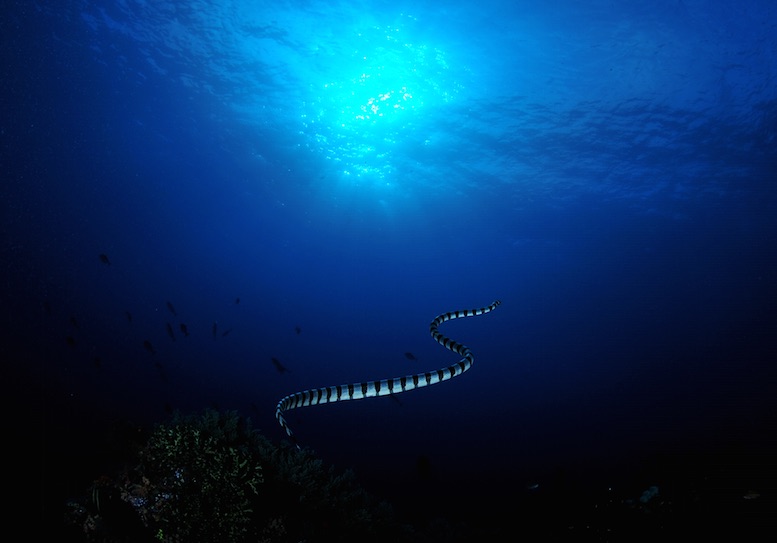
“The activity is definitely hotting up, but we are shocked and saddened to discover that the population of green and banded sea snakes at Gili Manuk is severely depleted.” © Aaron Wong
Hammer time
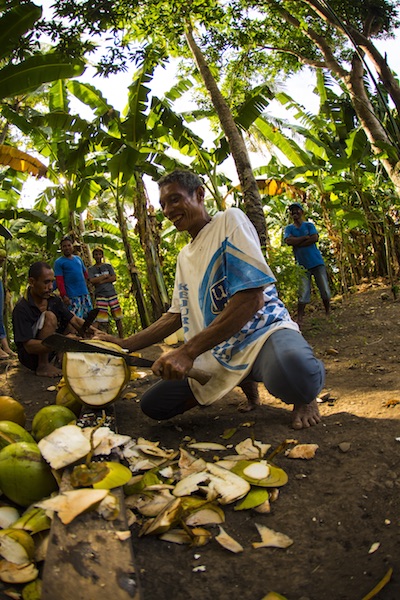
“We take a trip over to ‘Hammer Island’ and are given a hugely warm welcome by the villagers and chief.” © Aaron Wong
As if awaiting our arrival at “Hammer Island” a solitary hammerhead shark almost immediately emerges from the gloom, scoping the scene, about five metres long, muscular and powerful. He dips away from sight, and, apparition-like, over 120 hammerheads appear, schooling their way through the blue.
Everyone is hanging in the water, completely still, it is a staggering sight. We fin after them as they pass but they are gone as mysteriously as they appeared. I slowly turn back towards the reef and I am staggered to see the sentinel just three metres behind me, maybe five metres long. He weaves his way in pursuit of the school, for a heart-stopping moment appearing to come towards me as he snakes past. Huge dogtooth tuna, and big-eyed trevally follow, and I barrel-roll in wonder and look up and see the volcano 25 metres above me then sloping into nothingness, thousands of metres below; how tiny and insignificant we really are.
We take a trip over to “Hammer Island” and are given a hugely warm welcome by the villagers and chief. We donate some diesel, a radio, rice and some sugar. Tarpaulins are laid out with cloves in different stages of drying in the baking heat; this is one of the things these Spice Islands are famous for. The village has existed for around 150 years. They use traditional medicine from the plants they grow and their greatest challenge is lack of fresh running water. They fish the reef here, but are already doing this sustainably, only taking what they need for their people to survive. There is much that can be learned from them, and we have so many questions. Judi Lowe has some time with the chief of the village to ask him what the people want for their island and community over the next 15 years, whether they welcome tourism, and what that would mean for their community. This is all extremely valuable information for the Expedition and to continue Judi’s research (you can learn more about her research here at Asian Diver). The chief accompanies us back to the Samambaia ahead of our sunset dive, to say a prayer for more hammer sightings and sure enough some of us reap the rewards!
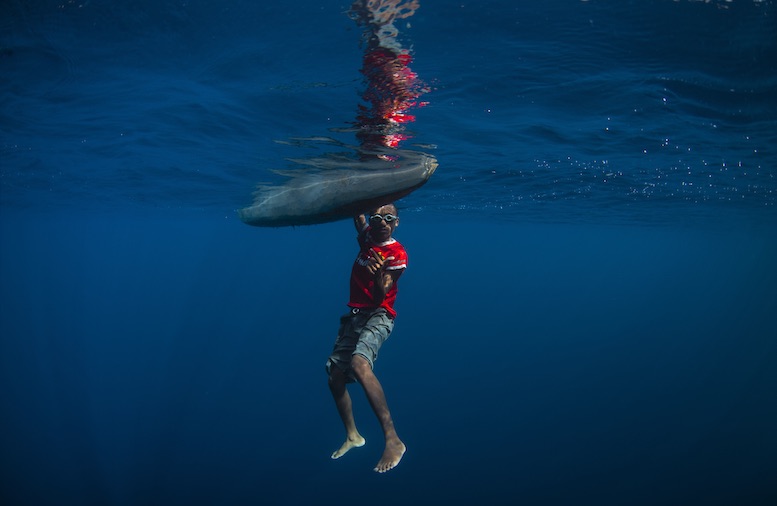
“They fish the reef here, but are already doing this sustainably, only taking what they need for their people to survive.” © Aaron Wong
We have another opportunity to give back to the local community at the next stop, when the women who weave the beautiful ikat drift across the water to show us their wares. We are spoiled for choice with traditional cream and blue colours to bright turquoise and red.
Water-time with the whales
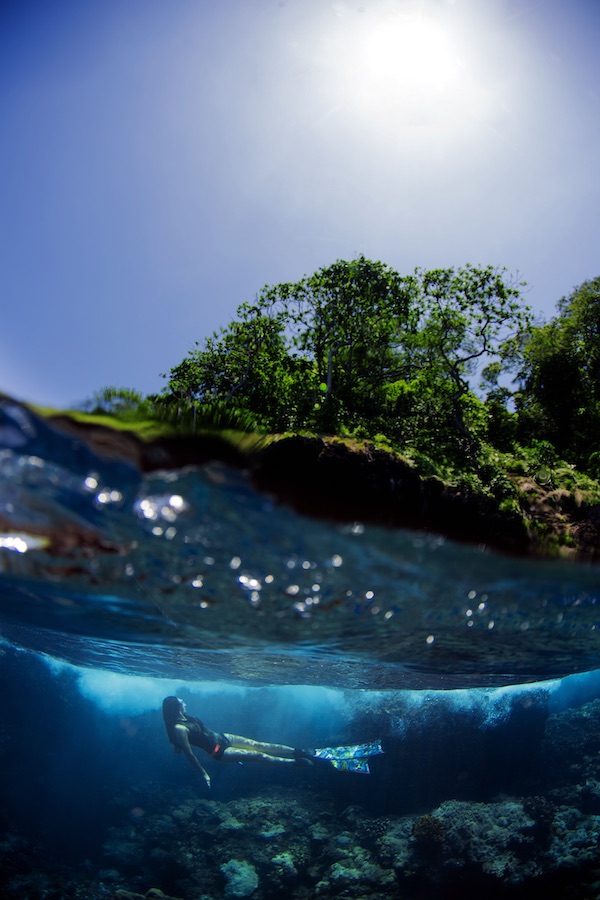
“Pepe Arcos is hoping to film Dada interacting with the cetaceans, filming her on breath-hold, too. Sadly it wasn’t to be; as soon as we drop into the water, they flee.” © Aaron Wong
A solitary blue whale sighting the following day is out of character; evasive and elusive, and we soon lost him. The reason for this would become clear in a couple of days.
Huge pods of dolphins and melon-headed whales surround us and present us with an opportunity to get in the water with them. Award-winning filmmaker and freediving champion, Pepe Arcos, is hoping to film Dada interacting with the cetaceans, filming her on breath-hold, too. Sadly it wasn’t to be; as soon as we drop into the water, they flee. We have to be content with the bottlenose dolphins bow-riding the speedboat. The water is crystal clear and they appear almost like animation as they duck and weave and play with us.
Our final stop of the expedition is Pantar. It’s muck diving and critters galore – a thorny seahorse, mandarinfish and a jawfish with eggs in her mouth. An outstanding night dive with blue spotted rays, dwarf cuttlefish, bumblebee shrimp, emperor shrimp, dragon sea moth and many crab species, there was not enough space in my dive log to write everything down!
Our last long push now to Kupang, and the final opportunity for whale watching. After a quiet couple of days, we all hope we are going to finish the trip with something spectacular. Despite perfect spotting conditions, it’s all suspiciously quiet, even the hydrophone failing to identify a presence. Finally in the afternoon we hear the call of a sighting, “BLOW!”. It’s a species we have not seen before, and very soon the elusiveness of the last few days is explained when we realise that we are looking at orcas. The other species have been running scared! The orcas also quickly disappear; it’s a mere fleeting glance. We bob quietly in the water hoping to get closer to them, but sadly after an hour and half, we have to continue the last leg of what has been a truly epic journey.
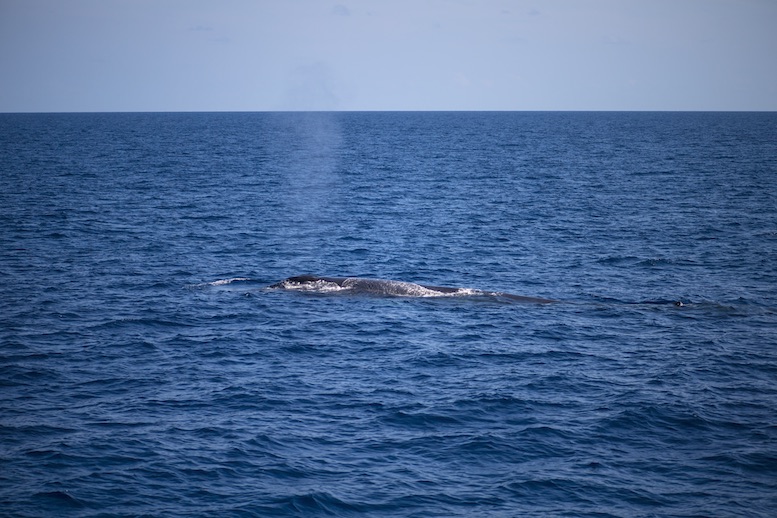
“A solitary blue whale sighting the following day is out of character; evasive and elusive, and we soon lost him.” © Aaron Wong
Download the article here




